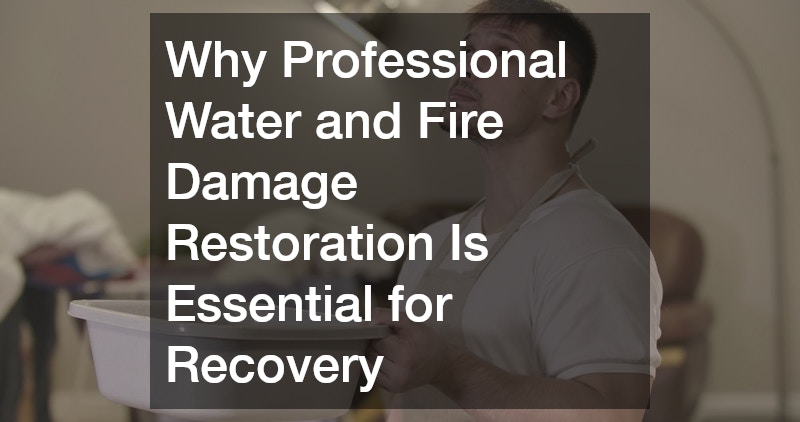
Why Professional Water and Fire Damage Restoration Is Essential for Recovery
In the face of disasters such as floods or fires, the journey to recovery can be challenging. Professional water and fire damage restoration services play a critical role in restoring homes and businesses to their pre-disaster state. This article explores the importance of these services and why they are essential for effective recovery.
Expertise and Equipment
Professional restoration companies are equipped with specialized knowledge that is crucial for effective recovery. They use advanced equipment such as industrial-grade dehumidifiers, air movers, and moisture detection tools. Through their expertise and resources, they are capable of addressing the intricate challenges presented by water and fire damage.
Such restoration requires a keen understanding of different materials and damage types, which only trained professionals can provide. Furthermore, professionals are continuously updated with training on the latest restoration techniques and safety protocols. This ensures that every restoration project they handle is approached with precision and care.
Efficiency and Timeliness
Time is of the essence when it comes to damage restoration, as delays can exacerbate existing issues. Professional teams are trained to act swiftly, minimizing the time between damage occurrence and restoration commencement. This prompt response is essential in preventing secondary damage, such as mold growth or structural weaknesses.
The efficiency brought about by professional restoration can significantly reduce the overall time needed to restore property. Their prioritization of key tasks ensures that critical areas are addressed first, streamlining the recovery process. This systematic approach minimizes disruptions for homeowners and business operators.
Comprehensive Assessment and Planning
Before any restoration can begin, professionals conduct a thorough assessment of the damage. This comprehensive evaluation allows for the creation of a targeted restoration plan that addresses all areas of concern. The tailored approach ensures that all specific needs and challenges are identified and strategically tackled.
Understanding the scope of damage is crucial for effective recovery, and professionals deploy various diagnostic tools and techniques to do so. From moisture mapping to structural evaluations, each assessment step is tailored to aid in the precise planning of restoration activities. This ensures that resources are allocated efficiently and results in effective outcomes.
Mold and Bacteria Mitigation
Water damage can result in mold and bacteria growth, posing significant health risks if not addressed. Professionals mitigate these hazards by employing techniques like thorough drying and antimicrobial treatments. Their expertise in detecting mold, even in hidden spaces, ensures that all risks are managed effectively.
Mold can trigger allergic reactions, respiratory problems, and other health issues, underscoring the importance of professional intervention. By utilizing specialized equipment and methods, professionals successfully halt mold propagation early in the restoration process. This proactive approach protects inhabitants from potential health complications.
Structural Integrity and Safety
Assessing and ensuring the structural integrity of a building post-disaster is critical for safety. Professionals conduct thorough inspections to identify any weaknesses or damage that could compromise stability. This careful evaluation determines the necessary repairs to restore the structure’s safety.
Erosion from water or damage from fire can weaken key structural components, making professional assessment crucial. Restoration experts have the training to detect hidden damage that might not be visible to the untrained eye. Addressing these concerns is essential in preventing future accidents or collapses.
Air Quality and Environmental Concerns
Air quality is often compromised in the aftermath of a fire or flood, necessitating professional attention. Smoke and soot residues, as well as mold spores, can significantly degrade indoor air quality. Restoration professionals employ air scrubbers, deodorizers, and ventilation techniques to restore clean air.
Environmental concerns also need to be considered, as water and fire damage can introduce hazardous materials. Professionals safely handle the disposal of such materials, ensuring compliance with environmental regulations. This is crucial for safeguarding both the natural environment and the health of the building’s occupants.
Cost-Effectiveness and Value
Investing in professional restoration services can offer cost savings compared to DIY methods. Professionals tackle both visible and hidden damage, reducing the likelihood of future issues that could lead to expensive repairs. Their expertise and efficiency prevent the escalation of damages, which in turn preserves property value.
Restoration companies provide value by delivering high-quality results that DIY efforts might fail to achieve. Their comprehensive approach ensures that all aspects of damage are addressed, leaving no room for oversights that could be costly in the future. Additionally, they often work with suppliers to obtain materials at preferential rates, further reducing costs.
Experience and Certification
Working with certified professionals ensures that restoration work meets industry standards and safety regulations. Certifications provide assurance of the knowledge and skills essential for effective restoration. Experienced professionals leverage their extensive backgrounds to manage complex restoration challenges.

